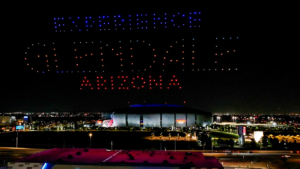The Grand Canyon State is on a winning streak.
“Arizona enjoyed an elevated three-year run in the sports tourism spotlight just a few years ago and that’s paying dividends in recent years,” says Kim Sabow, president and CEO of the Arizona Lodging and Tourism Association (AzLTA). “Mega events are significant to Arizona’s tourism industry and our economy holistically.”
And the economic impact of hosting sports’ biggest events has been powerful.
• $719 million from the Pro Bowl and Super Bowl in 2015
• $274 million from the College Football Championship in 2016.
• $324 million from the Final Four in 2017.
“That’s a total of $1.3 billion economic impact,” Sabow says. “The value surpasses the immediate results in other ways, too, including the incredible exposure Arizona receives during the build-up and time of the actual event elevating Arizona to a global spotlight for millions of people to see.”
In addition, Sabow says the sports fans that come here to attend events often relocate to Arizona or set up their businesses in the state after vacationing here and witnessing what the state has to offer. Az Business talked with Sabow about her industry. Here’s what she had to say.
Az Business: What is the state of Arizona’s lodging and tourism industry as we begin 2020?
Kim Sabow: We are moving confidently into 2020 and anticipate another year of steady growth. Although we are entering an election year which can sometimes result in uncertainty for the industry, Arizona is well- positioned as an appealing destination by millions across the world.
We are ending 2019 experiencing year-to-date growth. According to STR, the premium data benchmarking and analytics provider for the hospitality industry, there was a 1.9% increase in occupancy rate, over 2% growth in average daily rate (ADR) and over 4% in revenue per available room (RevPar). The Arizona Office of Tourism reported a 3.7% increase in passenger air traffic in October compared to 2018.
As the leading voice for our industry, the Arizona Lodging and Tourism Association (AzLTA) will engage Arizona lawmakers on issues impacting our members. We will continue to advocate for additional dollars for the Arizona Office of Tourism, strengthening local authority on online short-term rentals, preventing harmful peer-to-peer car rental legislation, creating awareness and providing education to end human trafficking, to name just a few.
In addition, another challenge that our industry faces is a workforce shortage. With education being a key pillar of AzLTA’s mission, I am pleased to share that our Education-Workforce Grant has been approved for an extension by Governor Doug Ducey. To date, we have 30 registered apprentices, 21 student scholarships benefiting students at ASU, NAU, UofA, GCU, Scottsdale Community College and Pima Community College. We will continue to work hard to inspire and guide young people to pursue careers in the hospitality and tourism industry.
AB: There has been a lot of legislative effort recently to make it easier for Mexican visitors to travel to Arizona. How important is Mexico to Arizona’s tourism trade?
KS: As a border state, Arizona’s relationship with Mexico is especially strong, something our family ties, interdependent economy, and interconnected culture demonstrate. To build upon this solid foundation and grow together, the Arizona tourism industry and business community are strongly supportive of the United States-Mexico-Canada Agreement, or USMCA. This modernized agreement will strengthen the U.S. economy and bolster international travel. According to U.S. Travel estimates, adoption of USMCA would raise $1.7 billion in travel generated economic output and create 15,000 jobs. Nearly 3.6 million people from Mexico choose Arizona as a travel destination each year, spending more than $7 million a day dining in our restaurants, staying at our hotels, and shopping in our stores.
We are also supportive of a bill introduced by Senator Martha McSally and Representative Greg Stanton last week to expand tourism and recreation in Arizona. The Southwest Tourism Expansion Act would create a pilot program to allow certain visitors from Mexico who already have permission to enter the United States to travel throughout the state of Arizona. Current law limits the distance Mexican nationals can travel once they cross the border into Arizona. This bill would promote tourism throughout our state generating additional visitor spending and increase employment opportunities.
AB: How about our neighbors to the north? How important are Canadian visitors to Arizona’s tourism trade?
KS: Arizona’s ties with Canada are deep as well. In fact, Canada is Arizona number one source of foreign investment. During the winter months, Canadian license plates cover our roads as visitors escape the deep freeze in their hometown and head to the desert sun. In 2018, we welcomed nearly 1 million Canadian visitors to Arizona spending $1 billion in our state. Our strong relationship with Canada as also led to economic development with approximately 400 Canadian companies operating in Arizona.
We are very thankful for the 210 direct flights weekly between Canada and Arizona with more coming this winter by a fast-growing low-cost Canadian air carrier – Swoop.
The Canada Arizona Business Council (CABC) lead by Glenn Williamson has been instrumental in growing and strengthening Arizona’s connections with Canadians on both a leisure and business front.
AB: A lot of resorts and spas have recently undergone major renovations. What is spurring all this increase investment?
KS: The growth we have experienced as a leisure destination and the need for future sustainability to compete with other destinations resulted in our hotels and resorts investing in their properties and amenities to ensure Arizona continues to offer some of the best accommodations in the world. You will continue to see improvements to keep up with the needs of technologically savvy, millennial and social travelers. It isn’t so much about the demographic differences of millennial travelers or baby boomers – it is a mindset – travelers want a social, connected and local experience.
Some sizeable upgrades and additions in the Valley include:
• The new Andaz Scottsdale Resort & Bungalows, which was the former Cottonwoods Resort, was completely torn down and re-imagined. It offers 34 bungalows scattered across 23 acres with 187 guestrooms in midcentury modern design. This was a $75-million project.
• Mountain Shadows originally opened in 1959 and was a favorite for local influencers and Hollywood stars. The new Mountain Shadows takes pride of these early days, but this $60 million project is unique in every way with its incredible backdrop of Camelback and Mummy mountains allowing all guest rooms to have a mountain view.
• The luxurious and iconic Phoenician Resort has also been revamped in the last three years including a new three-story spa that features a rooftop pool as well as a renovated golf course and athletic club.
There are so many more to mention but for the sake of time, I’ll just say be sure to check out the new pool at the Fairmont Scottsdale Princess, the renovations at the Scottsdale Resort at McCormick Ranch, updates at the Hermosa Inn, the new Hotel Adeline, and renovations at the Hotel Valley Ho, Sanctuary, and Scott Resort. I am certain we will continue to have exciting new things to talk about regarding our resorts and destination as a whole.
I must also mention how thrilled we are to welcome the new 20-acre Ritz-Carlton Resort overlooking Camelback Mountain which is scheduled to open in 2020.
AB: Arizona continues to attract mega events – we have another Super Bowl coming in 2023. How important are these mega-events to Arizona’s tourism industry?
KS: Arizona enjoyed an elevated three year run in the sports tourism spotlight just a few years ago and that’s paying dividends in recent years. Mega-events are significant to Arizona’s tourism industry and our economy holistically.
The economic impact of our most recent events has been powerful:
• $719 million from the Pro-Bowl and Super Bowl
• $274 million from the College Football Championship
• $324 million from the Final Four
That’s a total of $1.3 billion economic impact! The value surpasses the immediate results in other ways too including incredible exposure Arizona receives during the build-up and time of the actual event elevating Arizona to a global spotlight for millions of people to see what Arizona has to offer such as our breathtaking landscapes that are often captured when the event is aired. In addition, the sports fans that come here to attend the event have the opportunity to experience our quality of life adding increased value to our number-one-service export. Those memories and experiences lead to future visits. As many of us can relate to in our own life or those that live in our community, many current residents relocated to Arizona after they vacationed here. They wanted to experience our quality of life on a daily basis, which contributes to our state’s overall economic health. Mega events lead to immediate significant economic impacts and have residual benefits for years to come. That’s why we must continue to compete against other destinations to secure more Mega Events.
AB: Why do you think Arizona has been so successful in attracting these mega-events?
KS: We are fortunate to have many influential individuals in Arizona leading our sports industry such as Michael Bidwill of the Arizona Cardinals, who has been instrumental in helping to secure the Super Bowl coming back to Arizona in 2023. In addition, leaders of our destination marketing organizations – Steve Moore of Visit Phoenix and Rachel Sacco of Experience Scottsdale strongly collaborated to position Arizona as an ideal location for specific mega-events. Showcasing a seamless cohesiveness across the industry and to all other entities involved is critical to ensure a successful event. There are a number of factors that need to be considered when preparing for a bid on a mega event. Arizona tourism and business leaders to come together to assure we are prepared in every way including infrastructure, security, hotel room availability, airport and rental car logistics and capacity.
In addition to our strong collaboration, Arizona is an appealing destination for a mega event for all the reasons we all love living here and for the same reasons we welcomed 45 million visitors last year. Our weather and beautiful landscape along with ample options in accommodations and air service and equally importantly – our previous proven capability as a destination to successfully handle a mega event and all that goes with it.
AB: What are you most excited about – in regard to Arizona’s tourism industry – heading into 2020?
KS: 2020 will be another growth year for the travel and tourism industry. With a robust pipeline of new hotels and resorts planned and in construction across Arizona, it will be exciting to welcome new members to AzLTA as well as be prepared for another record year of business and leisure travelers. Our airports, airlines, sport teams and venues are all on an upward trajectory as well. We expect a fast-moving, dynamic legislative session and enter it with strong relations and a deep value for tourism by our elected leaders. With our continued focus on advocacy, collaboration and education, it’s going to be an incredibly thrilling year.




